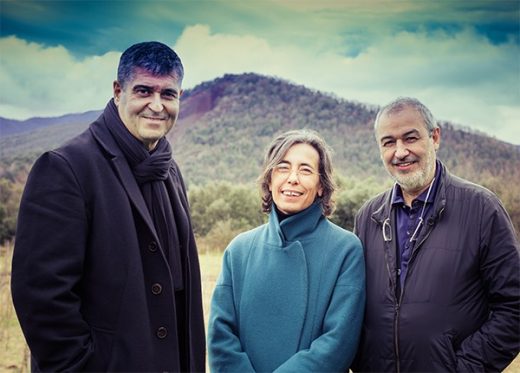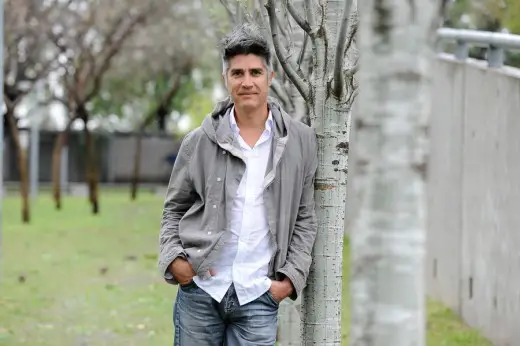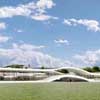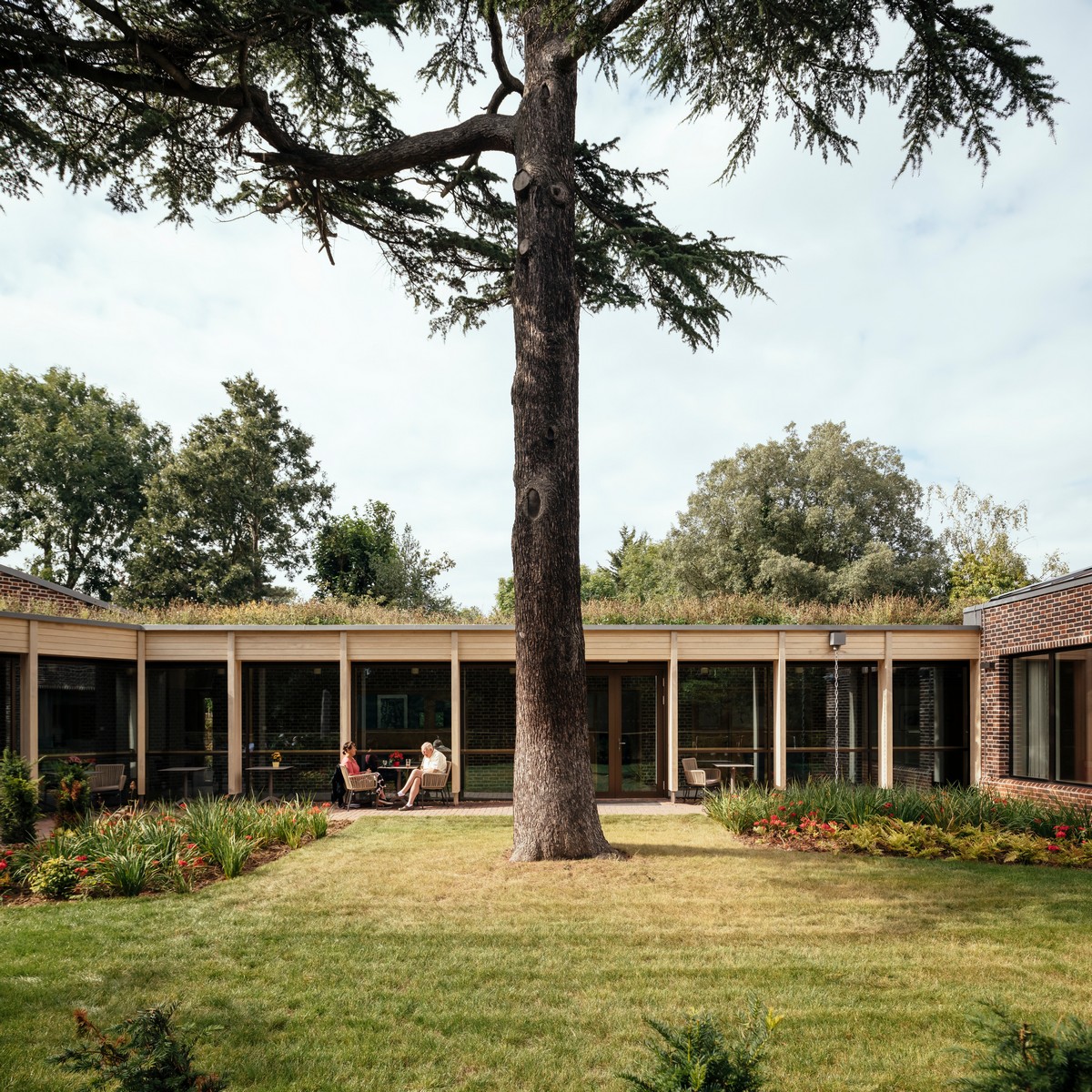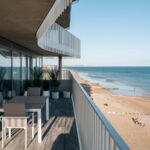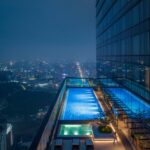2024 Pritzker Architecture Prize winner, Architect Riken Yamamoto designer, Award winner news, Building design
2024 Pritzker Architecture Prize winner
Architects Winners through the Years – Links to International Architectural Information
30 + 10 + 8 March 2024
Riken Yamamoto receives the 2024 Pritzker Architecture Prize
The Pritzker Architecture Prize announces Riken Yamamoto, of Yokohama, Japan, as the 2024 Laureate of the Pritzker Architecture Prize, the award that is regarded internationally as architecture’s highest honor.
Riken Yamamoto, born 1945 Beijing, China is a Japanese architect.
Riken Yamamoto:
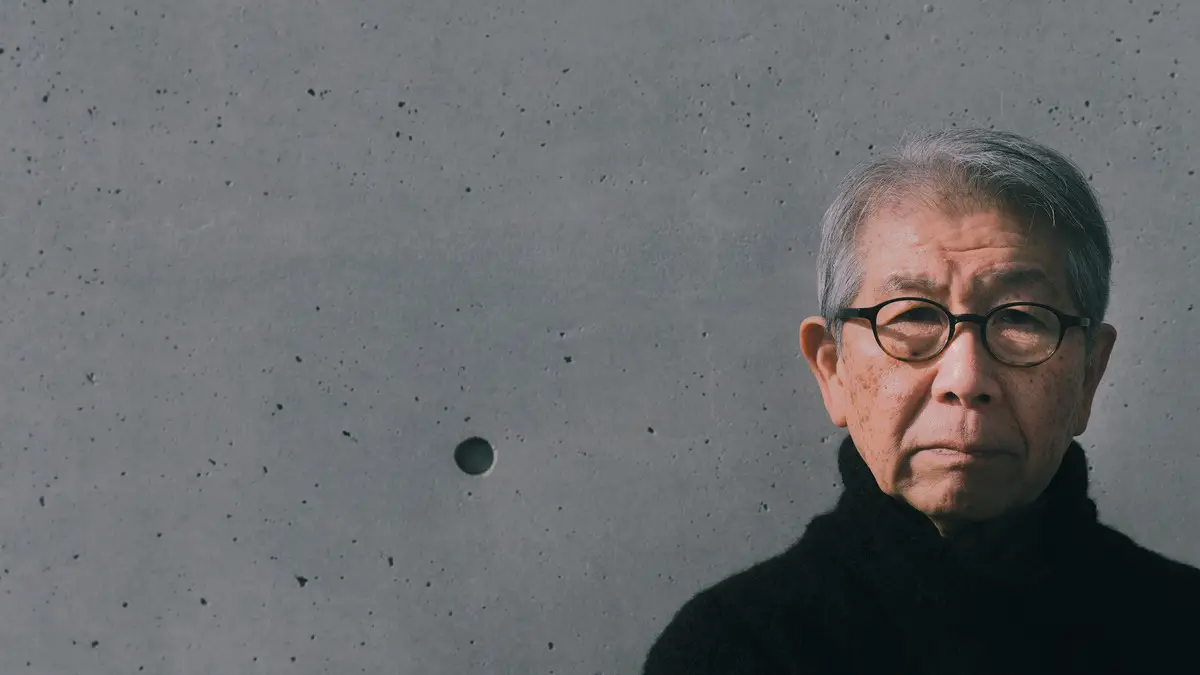
photo courtesy of Tom Welsh
5 March 2024
Riken Yamamoto Receives the 2024 Pritzker Architecture Prize
Yamamoto, architect and social advocate, establishes kinship between public and private realms, inspiring harmonious societies despite a diversity of identities, economies, politics, infrastructures, and housing systems. Deeply embedded in upholding community life, he asserts that the value of privacy has become an urban sensibility, when in fact, members of a community should sustain one another. He defines community as a “sense of sharing one space,” deconstructing traditional notions of freedom and privacy while rejecting longstanding conditions that have reduced housing into a commodity without relation to neighbors. Instead, he bridges cultures, histories and multi-generational citizens, with sensitivity, by adapting international influence and modernist architecture to the needs of the future, allowing life to thrive.
Ecoms House, Tosu city, eastern part of Saga Prefecture, island of Kyushu, Japan:
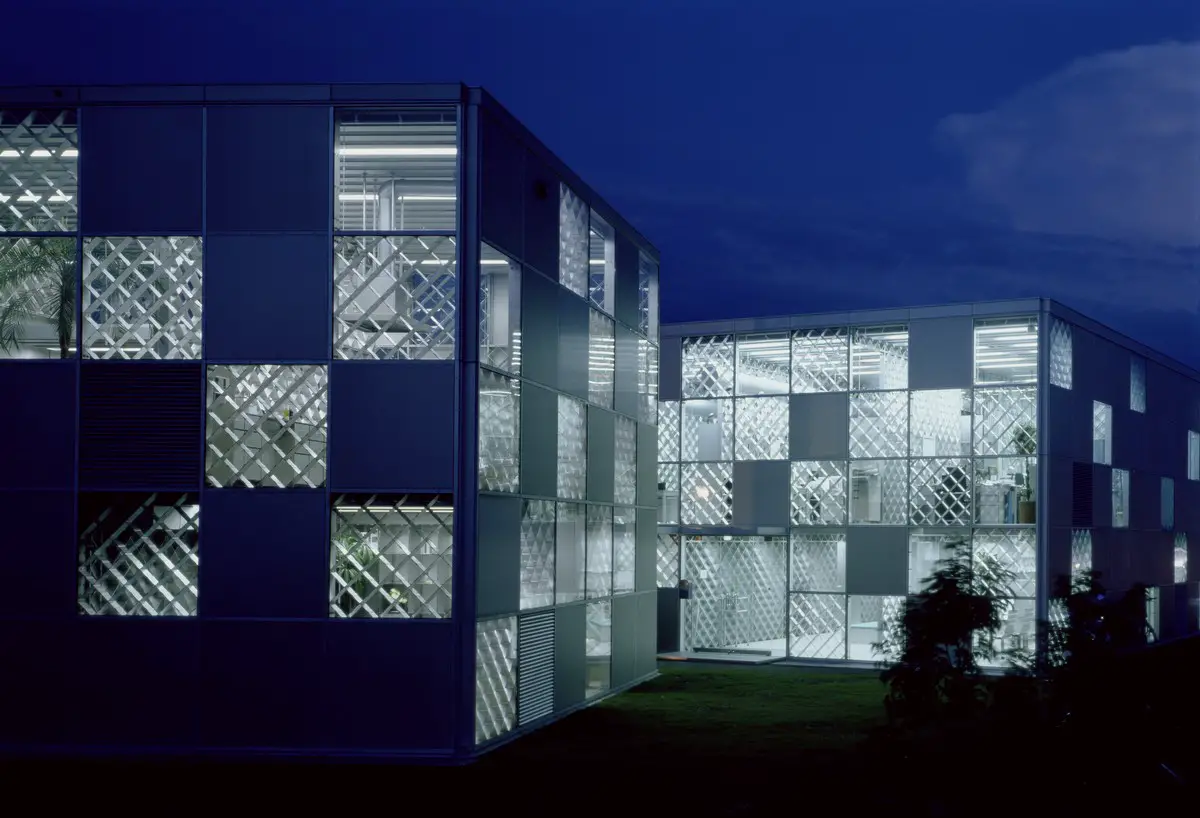
photo courtesy of Shinkenchiku Sha
“For me, to recognize space, is to recognize an entire community,” Yamamoto expresses. “The current architectural approach emphasizes privacy, negating the necessity of societal relationships. However, we can still honor the freedom of each individual while living together in architectural space as a republic, fostering harmony across cultures and phases of life.”
The 2024 Jury Citation states, in part, that he was selected “for creating awareness in the community in what is the responsibility of the social demand, for questioning the discipline of architecture to calibrate each individual architectural response, and above all for reminding us that in architecture, as in democracy, spaces must be created by the resolve of the people…”
By reconsidering boundary as a space, he activates the threshold between public and private lives, achieving social value with every project, as each abounds with places for engagement and chance encounters. Small- and large-scale built works alike demonstrate masterly qualities of the spaces themselves, providing focus on the life that each one frames. Transparency is utilized so that those from within may experience the environment that lies beyond, while those passing by may feel a sense of belonging. He offers a consistent continuity of landscape, designing in discourse to the preexisting natural and building environments to contextualize the experience of each building.
He has evolved influences from traditional Japanese machiya and Greek oikos housing that existed in relationship to cities, when connectivity and commerce were essential to the vitality of every family. He designed his own home, GAZEBO (Yokohama, Japan 1986) to invoke interaction with neighbors from terraces and rooftops. Ishii House (Kawasaki, Japan 1978), built for two artists, features a pavilion-like room, that extends outdoors and serves as a stage to host performances, while living quarters are embedded beneath.
“Yamamoto develops a new architectural language that doesn’t merely create spaces for families to live, but creates communities for families to live together,” says Tom Pritzker, Chair of the Hyatt Foundation, which sponsors the award. “His works are always connected to society, cultivating a generosity in spirit and honoring the human moment.”
Larger housing projects also embody relational elements, assuring that even residents who live alone don’t dwell in isolation. Pangyo Housing (Seongnam, Republic of Korea 2010), a complex of nine low-rise housing blocks is designed with nonprescriptive transparent ground floor volumes that catalyze interconnectedness between neighbors. A communal deck across the second floor encourages interaction, featuring spaces for gathering, playgrounds, gardens and bridges that connect one housing block to another.
“One of the things we need most in the future of cities is to create conditions through architecture that multiply the opportunities for people to come together and interact. By carefully blurring the boundary between public and private, Yamamoto contributes positively beyond the brief to enable community,” explains Alejandro Aravena, Jury Chair and 2016 Pritzker Prize Laureate. “He is a reassuring architect who brings dignity to everyday life. Normality becomes extraordinary. Calmness leads to splendor.”
Civic buildings achieving specific functions also affirm public purpose and assurance. The Hiroshima Nishi Fire Station (Hiroshima, Japan, 2000), appears entirely transparent, with its glass louvered façade and interior glass walls. Visitors and passersby may view through to the central atrium to witness the daily activity and training of firefighters, and are encouraged to grow acquainted with the civil servants who protect them in the many designated public areas of the building. Fussa City Hall (Tokyo, Japan 2008) is conceived as two mid-rise towers, rather than one high-rise to compliment the surrounding neighborhood of low-rise buildings. Concave bases invite visitors to recline and rest, while green public rooftop and lower levels are designated for flexible public programming.
Koyasu Elementary School, Yokohama, Japan:
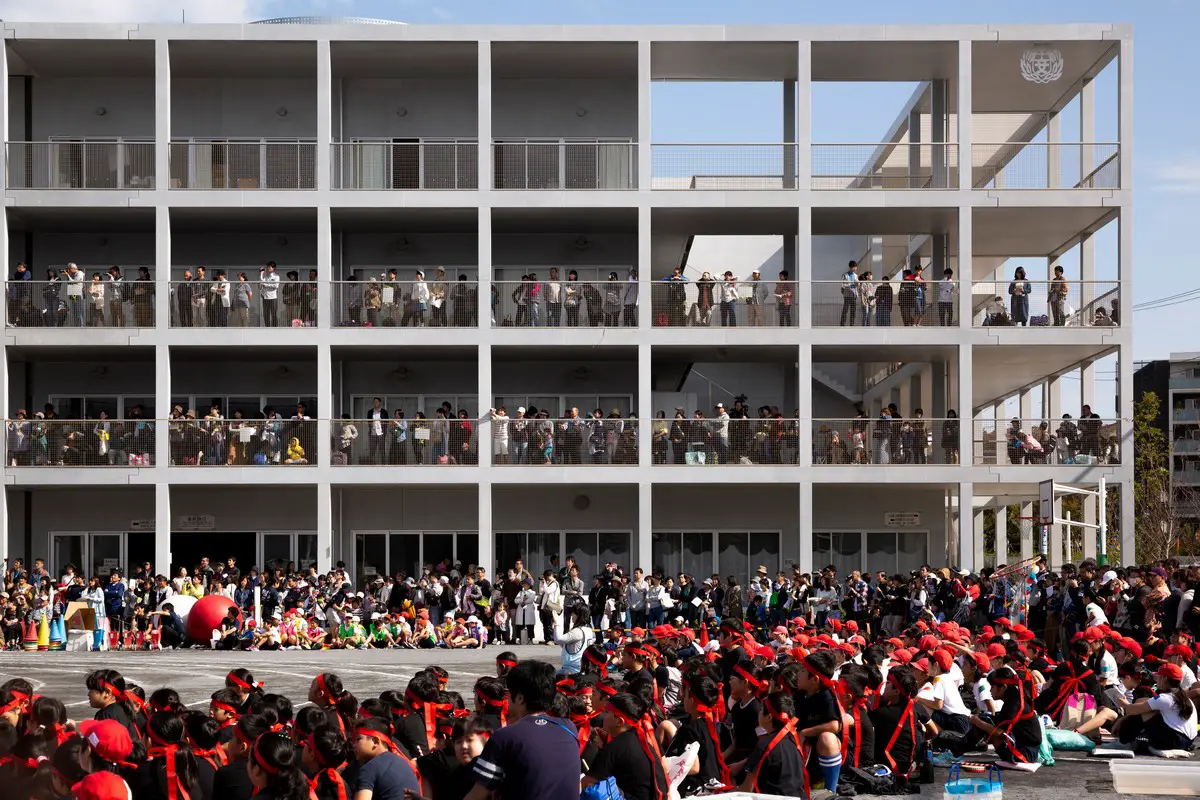
photo courtesy of Mitsumasa Fujitsuka
Saitama Prefectural University (Koshigaya, Japan 1999), specializing in nursing and health sciences, is composed of nine buildings connected by terraces that transition into walkways leading to transparent volumes that allow views from one classroom to another, but also from one building to the next, encouraging interdisciplinary learning. Such fellowship is fostered even within the youngest generations at Koyasu Elementary School (Yokohama, Japan 2018), which features generous, undivided terraces extending learning spaces, permitting sights into and from each classroom, and encouraging relationships amongst students across grades levels.
Yokosuka Museum of Art:
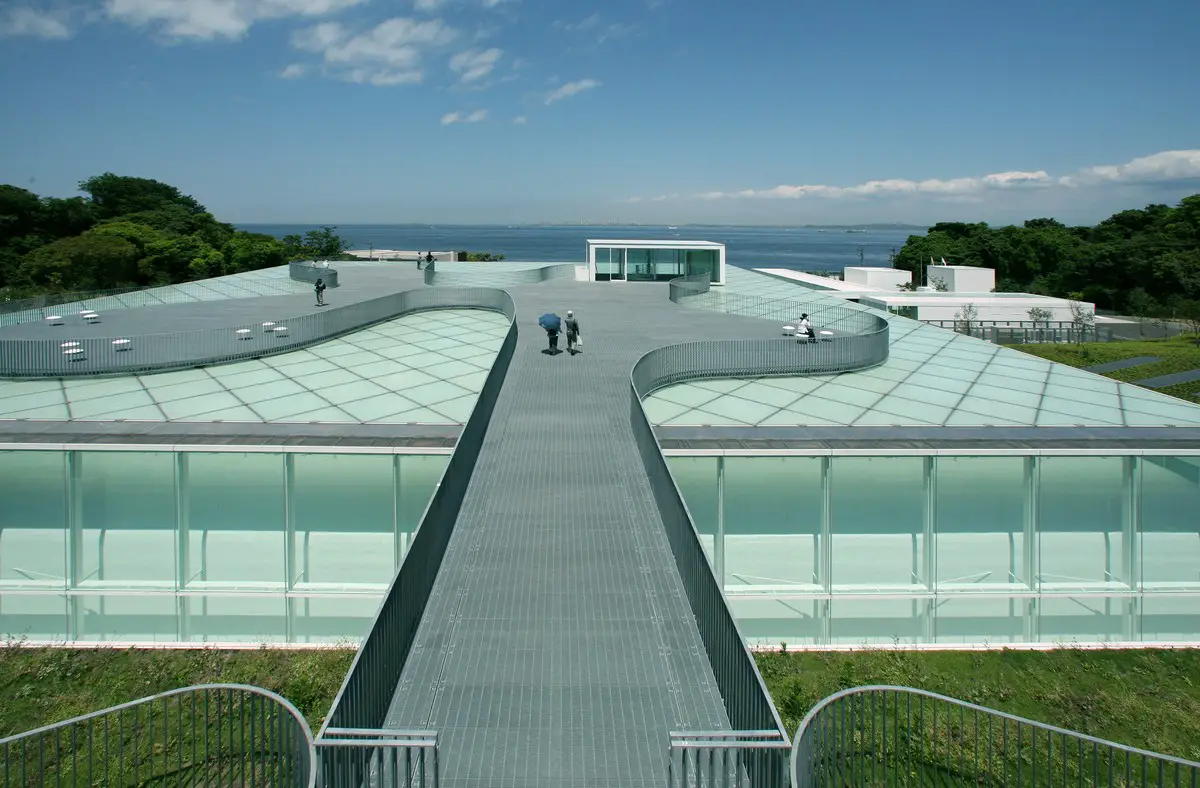
photo courtesy of Tomio Ohashi
He considers the user experience first, designing Yokosuka Museum of Art (Yokosuka, Japan 2006) as both a destination for travelers and a daily reprieve for locals. While the inviting serpentine entrance evokes the surrounding Tokyo Bay and nearby mountains, many of the galleries are underground, providing those who approach with a clear, undisturbed visual experience of the natural geography. Visitors may view through to the landscape and other galleries from round cutouts in all common spaces, uniting these otherwise distinctive environments so that those inside are impressed upon not only by the artwork, but by the activity of others in the spaces alongside them.
His career has spanned five decades and his projects, ranging from private residences to public housing, elementary schools to university buildings, institutions to civic spaces, and city planning, are located throughout Japan, People’s Republic of China, Republic of Korea and Switzerland. Significant built works also include Nagoya Zokei University (Nagoya, Japan, 2022), THE CIRCLE at Zürich Airport (Zürich, Switzerland, 2020), Tianjin Library (Tianjin, People’s Republic of China, 2012), Jian Wai SOHO (Beijing, People’s Republic of China, 2004), Ecoms House (Tosu, Japan, 2004), Shinonome Canal Court CODAN (Tokyo, Japan, 2003), Future University Hakodate (Hakodate, Japan, 2000), Iwadeyama Junior High School (Ōsaki, Japan, 1996) and Hotakubo Housing (Kumamoto, Japan, 1991).
Yamamoto is the 53rd Laureate of the Pritzker Architecture Prize and the ninth to hail from Japan.
He was born in Beijing, People’s Republic of China, and resides in Yokohama, Japan. He will be honored in Chicago, Illinois, United States of America this spring and the 2024 Laureate Lecture will be held at S. R. Crown Hall, Illinois Institute of Technology, in partnership with the Chicago Architecture Center, on May 16th, open to the public in-person and online.
The Pritzker Architecture Prize
The Pritzker Architecture Prize was founded in 1979 by the late Jay A. Pritzker and his wife, Cindy.
Its purpose is to honor annually a living architect or architects whose built work demonstrates a combination of those qualities of talent, vision and commitment, which has produced consistent and significant contributions to humanity and the built environment through the art of architecture.
###
Jury Citation
The Pritzker Prize is conferred in acknowledgment of those qualities of talent, vision and commitment, which have persistently produced significant contributions to humanity and the built environment through the art of architecture. In his long, coherent, rigorous career, Riken Yamamoto has managed to produce architecture both as background and foreground to everyday life, blurring boundaries between its public and private dimensions, and multiplying opportunities for people to meet spontaneously, through precise, rational design strategies.
By the strong, consistent quality of his buildings, he aims to dignify, enhance and enrich the life of individuals—from children to elders—and their social connections. And he does this through a selfexplanatory yet modest and pertinent architecture, with structural honesty and precise scaling, with careful attention to the landscape of the surroundings.
His architecture clearly expresses his beliefs through the modular structure and the simplicity of its form. Yet, it does not dictate activities, rather it enables people to shape their own lives within his buildings with elegance, normality, poetry and joy.
Riken Yamamoto deliberately engages with the widest range of building types as well as scales in the projects he chooses. Whether he designs private houses or public infrastructure, schools or fire stations, city halls or museums, the common and convivial dimension is always present. His constant, careful and substantial attention to community has generated public interworking space systems that incentivize people to convene in different ways. The entire building space of the Saitama Prefectural University (1999), for instance, is conceived as a community.
Yamamoto suggests rather than imposes this shared dimension through understated, yet precise architectural interventions. By including spaces for common activities within, in addition to and even regardless of the main function of his buildings, he allows these to integrate into the quotidian life of the community, instead of being only experienced in exceptional circumstances. The two departments for the students and researchers to work together in the Future University, Hakodate (2000), or the transparent louvred glass façade to expose the inner workings of the department in the Hiroshima Fire Station (2000) both exemplify his belief in the concept of transparency as a reflection of the functionality and accessibility of the space for users and viewers alike.
As a young architect born in China and trained in Japan, he felt the urgency to complete his own education with a real understanding of the ‘other than the self.’ He extensively travelled not (primarily) to visit renowned monuments, but rather to experience at first hand the culture and everyday life of communities on other continents. From North to South America, across the Mediterranean to the Middle East and Asia, Yamamoto has investigated the roots and history of community life that he might bring his own contribution to the modernization of the contemporary city through architecture. For him a building has a public function even when it is private.
Riken Yamamoto is not an architecture historian, yet he learns from the past as well as from different cultures. As an architect, he does not copy from the past, rather he adapts, re-uses and evolves, showing that fundamentals persist in their relevance. Yamamoto has expanded the toolbox of the profession towards both the past and the future to be able to give each time, in very different modes and at very different scales, the most pertinent response to the challenges of both the built environment and of collective living.
For creating awareness in the community in what is the responsibility of the social demand, for questioning the discipline of architecture to calibrate each individual architectural response, and above all for reminding us that in architecture, as in democracy, spaces must be created by the resolve of the people, Riken Yamamoto is named the 2024 Pritzker Prize Laureate.
###
Jury Members
– Alejandro Aravena (Chair)
Architect, Educator and 2016 Pritzker Laureate
Santiago, Chile
– Barry Bergdoll
Architecture Historian, Educator, Curator and Author
New York, New York
– Deborah Berke
Architect and Dean, Yale School of Architecture
New York, New York
– Stephen Breyer
U.S. Supreme Court Justice
Washington, DC
– André Aranha Corrêa do Lago
Architecture Critic and Secretary for Climate, Energy and Environment,
Ministry of Foreign Affairs, Government of Brazil
Brasília, Brazil
– Kazuyo Sejima
Architect and 2010 Pritzker Laureate
Tokyo, Japan
– Wang Shu
Architect, Educator and 2012 Pritzker Laureate
Hangzhou, China
– Manuela Lucá-Dazio (Executive Director)
Venice, Italy
Biography
Japanese architect Riken Yamamoto (b. 1945) was born in Beijing, People’s Republic of China and relocated to Yokohama, Japan shortly after the end of World War II. Negotiating a balance between public and private dimensions from childhood, he lived in a home that was modeled after a traditional Japanese machiya, with his mother’s pharmacy in the front and their living area in the rear. “The threshold on one side was for family, and on the other side for community. I sat in between.”
Yamamoto knew little about his father, who had passed away when the architect was only five years old. In some ways, he sought to emulate his father’s career as an engineer, but instead forged his own path into architecture. At age 17, he visited Kôfuku-ji Temple, in Nara, Japan, originally built in 730 and finally reconstructed in 1426, and was captivated by the Five-storied Pagoda symbolizing the five Buddhist elements of earth, water, fire, air and space. “It was very dark, but I could see the wooden tower illuminated by the light of the moon and what I found at that moment was my first experience with architecture.”
He graduated from Nihon University, Department of Architecture, College of Science and Technology in 1968 and received a Master of Arts in Architecture from Tokyo University of the Arts, Faculty of Architecture in 1971. He founded his practice, Riken Yamamoto & Field Shop in 1973.
During the earliest years of his career, the architect spontaneously journeyed across countries and continents by car with his mentor, Hiroshi Hara, spending months at a time in pursuit of understanding communities, cultures and civilizations. In 1972, he drove along the coastline of the Mediterranean Sea, visiting France, Spain, Morocco, Algeria, Tunisia, Italy, Greece and Türkiye. Two years later, he traveled from Los Angeles to Mexico, Guatemala, Costa Rica and Colombia before reaching Peru. He would also embark on a similar expedition to Iraq, India and Nepal, and concluded that the idea of a “threshold” between public and private spaces was universal. “I recognize the past system of architecture is so that we can find our culture…The villages were different in their appearance, but their worlds [were] very similar.”
Yamamoto reconsidered boundaries between public and private realms as societal opportunities, committing to the belief that all spaces may enrich and serve the consideration of an entire community, and not just those who occupy them. With this in mind, he began designing single-family residences that united natural and built environments, welcoming to both guests and passersby. His first project, Yamakawa Villa (Nagano, Japan 1977), is exposed on all sides and situated in the woods, designed to feel entirely like an open-air terrace. The experience significantly influenced his future works as he extended into social housing with Hotakubo Housing (Kumamoto, Japan 1991), bridging cultures and generations through relational living.
Tianjin Library:
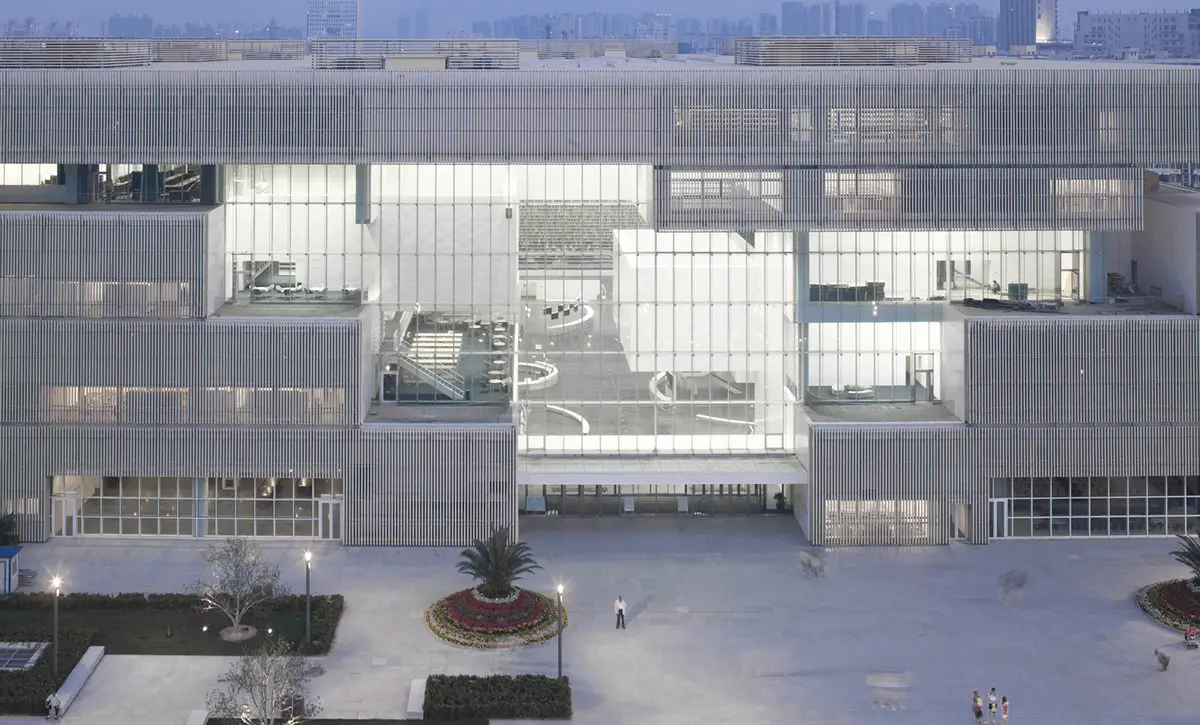
photo courtesy of Riken Yamamoto & Field Shop
Transparency, in form, material and philosophy remained an essential element in his works. He established an urban planning approach that demonstrated evolution as a vital property in the development of Ryokuen-toshi, Inter-Junction City (Yokohama, Japan 1994). Regardless of a building’s identity or function, a regulation constitutes that all must allow passage through its site, cohering adjacent plots and unifying neighboring landowners. He continued to prompt societies in large buildings by adapting his architectural language to projects such as Saitama Prefectural University (Koshigaya, Japan 1999), and Tianjin Library (Tianjin, Republic of China 2012), attesting to his mastery of scale.
His work grew more prolific, ranging from private residences to public housing, elementary schools to university buildings, and institutions to civic spaces, when natural disaster devastated Japan in 2011. In the aftermath of Tōhoku Earthquake and Tsunami, he established Local Area Republic Labo, an institute dedicated to community activities through architectural design; and instituted the Local Republic Award in 2018 to honor young architects who act with courage and ideals towards the future.
Yamamoto is a newly appointed visiting professor at Kanagawa University (Yokohama, Japan). He was a visiting professor at Tokyo University of the Arts (Tokyo, Japan 2022-2024) and has previously taught at Nihon University, Graduate School of Engineering (Tokyo, Japan 2011-2013); Yokohama National University, Graduate School of Architecture (Yokohama, Japan 2007-2011); Kogakuin University, Department of Architecture (Tokyo, Japan 2002-2007); and served as the President of Nagoya Zokei University of Art and Design (Nagoya, Japan 2018-2022).
He was appointed Academician by the International Academy of Architecture (2013) and has received numerous distinctions throughout his career including the Japan Institute of Architects Award for the Yokosuka Museum of Art (2010), Public Buildings Prize (2004 and 2006), Good Design Gold Award (2004 and 2005), Prize of the Architectural Institute of Japan (1988 and 2002), Japan Arts Academy Award (2001), and Mainichi Art Awards (1998).
Yamamoto continues to practice and reside in Yokohama, in community with his neighbors. His built works can be found throughout Japan, People’s Republic of China, Republic of Korea and Switzerland.
###
Built Works
2022
Nagoya Zokei University, Nagoya, Japan
2020
THE CIRCLE at Zürich Airport, Zürich, Switzerland
2019
Tokyo Weld Technical Center, Numazu, Japan
2018
Koyasu Elementary School, Yokohama, Japan
2016
Yokohama City University, Yokohama, Japan
2013
Yokohama Zoo Restaurant, Yokohama, Japan
Seoul Gangnam Housing, Seoul, Republic of Korea
2012
Home For All in Heita, Kamaishi, Japan
Tianjin Library, Tianjin, People’s Republic of China
2010
Pangyo Housing, Seongnam, Republic of Korea
2009
Namics Techno Core, Niigata, Japan
Utsunomiya University Center for Optical Research & Education, Utsunomiya, Japan
2008
Fussa City Hall, Tokyo, Japan
Dragon Lily’s House, Kiryu, Japan
2006
Yokosuka Museum of Art, Yokosuka or Kanagawa, Japan
2005
SUSTRG Office Project, Sukagawa, Japan
Future University Hakodate Research Building, Hakodate, Japan
2004
Ecoms House, Tosu, Japan
Jian Wai SOHO, Beijing, People’s Republic of China
2003
Shinonome Canal Court CODAN, Tokyo, Japan
2002
D Clinic, Saitama, Japan
2001
Tokyo Weld Technical Center, Numazu, Japan
Ban Building, Niigata, Japan
2000
Yokohama Mitsukyo Housing, Yokohama, Japan
Hiroshima Nishi Fire Station, Hiroshima, Japan
Future University Hakodate, Hakodate, Japan
1999
Saitama Prefectural University, Koshigaya, Japan
1998
Office Kitano, Tokyo, Japan
1996
Iwadeyama Junior High School, Osaki, Japan
Yamamoto Mental Clinic, Okayama, Japan
Shimoizumi Community Center & Shimoizumi Care Center , Yokohama, Japan
1995
House in Kamakura, Kamakura, Japan
1994
Ryokuen-toshi (Inter-Junction City) CŌTE á CŌTE, Yokohama, Japan
1993
Ryokuen-toshi (Inter-Junction City) AMNIS, Yokohama, Japan
Ryokuen-toshi (Inter-Junction City) LOGGIA, Yokohama, Japan
Ryokuen-toshi (Inter-Junction City) OBERISK, Yokohama, Japan
Ryokuen-toshi (Inter-Junction City) PRADO, Yokohama, Japan
Ryokuen-toshi (Inter-Junction City) ARCUS, Yokohama, Japan
1992
Ryokuen-toshi (Inter-Junction City) XYSTUS, Yokohama, Japan
Ryokuen-toshi (Inter-Junction City) G.F. Building, Yokohama, Japan
House in Okayama, Okayama, Japan
House in Katsushika, Tokyo, Japan
1991
Hotakubo Housing, Kumamoto, Japan
1989
Wakatsuki House, Kamakura, Japan
1988
HAMLET, Tokyo, Japan
1987
Marufuji (The Kosaku Store), Tokyo, Japan
ROTUNDA, Yokohama, Japan
Daiko Dormitory, Ashigarashimo-gun, Kanagawa, Japan
Fujii Gallery, Tokyo, Japan
1986
Marufuji (The Minamidenen Store), Tokyo, Japan
GAZEBO, Yokohama, Japan
Restaurant KIRARA, Tokyo, Japan
1985
Omata House, Yokohama, Japan
1984
Sato House, Tokyo, Japan
ESSES Gallery, Tokyo, Japan
1983
Niikura House, Tokyo, Japan
1982
Fujii House, Yokohama, Japan
1981
Seno House, Tokyo, Japan
1978
Yamamoto House, Yokohama, Japan
Ishii House, Kawasaki, Japan
Kubota House, Tokyo, Japan
1977
Yamakawa Villa, Nagano, Japan
Shindo House, Yokohama, Japan
1976
Mihira House, Yokohama, Japan
2012
Public Buildings Prize, Yokosuka Museum of Art, Tokyo, 2012
2010
Building Contractors Society Prize, Namics Techno Core, Tokyo, 2010
The Japan Institute of Architects Award, Yokosuka Museum of Art, Tokyo, 2010
2008
Building Contractors Society Prize, Yokosuka Museum of Art, Tokyo, 2008
2006
Building Contractors Society Prize, Shinonome Canal Court CODAN, Tokyo, 2006
2005
Good Design Award, Gold Prize, Shinonome Canal Court CODAN, Tokyo, 2005
2004
Public Buildings Prize, Hiroshima Nishi Fire Station, Tokyo, 2004
Public Buildings Prize, Future University Hakodate, Tokyo, 2004
2002
Building Contractors Society Prize, Future University Hakodate, Tokyo, 2002
Prize of the Architectural Institute Japan for Design, Future University Hakodate, Tokyo, 2002
2001
Building Contractors Society Prize, Hiroshima Nishi Fire Station, Tokyo, 2001
Japan Art Academy Prize, Saitama Prefectural University, Tokyo, 2001
2000
Building Contractors Society Prize, Saitama Prefectural University, Tokyo, 2000
1999
Good Design Award, Gold Prize, Saitama Prefectural University, Tokyo, 1999
1998
Mainichi Art Award, Iwadeyama Junior High School, Tokyo, 1998
1997
Building Contractors Society Prize, Iwadeyama Junior High School, Tokyo, 1997
1988
Prize of the Architectural Institute Japan for Design, GAZEBO and ROTUNDA, Tokyo, 1988
1985
SD Review Kajima Award, GAZEBO, Tokyo, 1985
Bibliography
2024
Yamamoto, Riken, editors. THE SPACE OF POWER, POWER OF SPACE. TWO VIRGINS, 2024.
*To be released in March 2024.
2023
Yamamoto, Riken, et al., editors. 地域社会圏主義|増補改訂版. TWO VIRGINS, 2023.
Yamamoto, Riken, et al., editors. 都市美 第3号 国家と住宅. KAWADE SHOBO
SHINSHA, 2023.
Riken Yamamoto & Field Shop, editors. MATERIALIZATION 山本理顕的設計監理思想 生まれ
変わる名古屋造形大学. The Kenchiku Gijutsu, 2023.
2021
Yamamoto, Riken, et al., editors. 都市美 第2号 公的空間の作法. KAWADE SHOBO
SHINSHA, 2021.
2019
Yamamoto, Riken, et al, editors. 都市美 創刊第1号 コミュニティ権 新しい希望. SAYUSHA, 2019.
2018
Yamamoto, Riken, Toshiharu Naka, editors. 脱住宅 「小さな経済圏」を設計する. HEIBONSHA
LIMITED PUBLISHERS, 2018.
2016
Yamamoto, Riken, et al., editors. いま、〈日本〉を考えるということ. KAWADE SHOBO
SHINSHA, 2016.
2015
Yamamoto, Riken, editors. 権力の空間/空間の権力 個人と国家の〈あいだ〉を設計せよ.
KODANSHA, 2015.
2013
Yamamoto, Riken, et al., editors. 地域社会圏主義|増補改訂版. LIXIL Publishing, 2013.
2012
Yamamoto, Riken, et al., editors. OURS TEXT 001—未来の住人のために. nobodymag, 2012.
Riken Yamamoto & Field Shop, editors. 釜石 平田 みんなの家 昼は、カフェ 夜は、居酒屋.
KYSYN-no-Kai, Local Republic Area Labo, Riken Yamamoto & Field Shop, 2012.
Yamamoto, Riken, editors. RIKEN YAMAMOTO 山本理顕の建築. TOTO Publishing, 2012.
2010
Yamamoto, Riken, editors. 私の建築手法 山本理顕. Tozai Asphalt Roofing Contractor’s Co-op
Association, 2010.
Yamamoto, Riken, et al., editors. 地域社会圏モデル 国家と個人のあいだを構想せよ.
LIXIL Publishing, 2010.
2008
Y-GSA (Yokohama National University), editors. 建築の新しさ、都市の未来. Shokokusha
publishing Co., 2008.
Fuchigami, Masayuki, et al., editors. 建築家をめざして アーキテクト訪問記.
Kensetsunews, 2008.
2007
Yamamoto, Riken, et al., editors. 建築をつくることは未来をつくることである.
TOTO Publishing, 2007.
2006
Yamamoto, Riken, editors.ドラゴン・リリーさんの家の調査 くうねるところにすむところ.
Index Communications, 2006.
Yamamoto, Riken, editors. 建築の可能性、山本理顕的想像力. Okokusha Publishing, 2006.
Yamamoto, Riken, editors. 建行道 山本理顕に耳を澄ませ. BankART, 2006.
Ishida, Yasuo, et al., editors. アルミニウムの空間. Shinkenchiku-sha Co., Ltd., 2006.
Yamamoto, Riken, et al., editors. 徹底討論 私たちが住みたい都市 身体・プライバシー・住宅・国家
工学院大学連続シンポジウム. HEIBONSHA, 2006.
2005
Taro Igarashi, et al., editors. 卒業設計で考えたこと。そしていま. Shokokusha
publishing Co., 2005.
Riken Yamamoto & Field Shop, editors. 国外建筑设计详图图集15 山本理显设计实例.
中国建筑工业出版社, 2005.
2004
Yamamoto, Riken, editors. 新編住居論. HEIBONSHA LIMITED PUBLISHERS, 2004.
2003
Yamamoto, Riken, Riken Yamamoto & Field Shop, editors. つくりながら考える/
使いながらつくる. TOTO Publishing, 2003.
Yamamoto, Riken, et al., editors. JA 51, Autumn 2003 Riken Yamamoto 2003.
Shinkenchiku-sha Co., Ltd., 2003.
2002
Yamamoto, Riken, et al., editors.私の建築手法 山本理顕・青木淳・内藤廣. Tozai Asphalt Roofing
Contractor’s Co-op Association, 2002.
2001
Riken Yamamoto & Field Shop, editors. 山本理顕/システムズストラクチュアのディテール.
Shokokusha publishing Co., 2001.
Yamamoto, Riken, editors. PLOT 01:山本理顕. A.D.A.EDITA Tokyo, 2001.
2000
Hemmi, Yō, editors. 屈せざる者たち. KADOKAWA Bunko, 2000.
1999
Yamamoto, Riken, et al., editors. 建築文化 1999 年7月号 特集 山本理顕 埼玉県立大学.
Shokokusha publishing Co.,1999.
Yamamoto, Riken, Wilhelm Klauser, editors. Riken Yamamoto. Birkhäuser Verlag GmbH, 1999.
Yamamoto, Riken, editors. Cell City La ville cellulaire. français d’architecture, 1999.
1997
Yamamoto, Riken, editors. Riken Yamamoto. Kajima Institute Publishing, 1997.
1996
Hemmi, Yō, editors. 屈せざる者たち. Asahi Shimbun Publications Inc., 1996.
1995
Yamamoto, Riken, et al., editors. SD 1995年1月号 特集 山本理顕. Kajima Institute
Publishing Co., Ltd. 1995.
1994
Yamamoto, Riken, et al, editors. 私の建築手法 原広司・山本理顕・石井和紘. Tozai Asphalt
Roofing Contractor’s Co-op Association, 1994.
1993
Yamamoto, Riken, editors. シリーズ 住まい学体大系 54 住居論. Sumai No Toshokan
Shuppansya, 1993.
Yamamoto, Riken, editors. 細胞都市. INAX Publishing, 1993.
1991
Yamamoto, Riken, editors. 緑園都市 山本理顕の建築. GALLERY・MA, 1991.
1988
Yamamoto, Riken, editors. 建築文化 1988年8月号 特集 山本理顕的建築計画学77/88.
Shokokusha publishing Co., 1988.
1986
Hiroshi, Hara, et al., editors. 建築 あすへの予感 離陸への準備. Shokokusha publishing Co., 1986.
Yamamoto, Riken, et al., editors. 現代建築 | 空間と方法 23 山本理顕. DOHOSHA
Publishing, 1986.
Ceremony Venue
Founded in the aftermath of the Great Chicago Fire, the Art Institute of Chicago opened its current location in 1893, situated in what has become the heart of Millennium Park. The Beaux Arts building was designed by Shepley, Rutan & Coolidge and has since evolved through eight major expansions, the latest of which established the Modern Wing, designed by Renzo Piano, 1998 Pritzker Prize Laureate, and his practice, Renzo Piano Building Workshop. The permanent collection presently includes over 300,000 works of art in fields ranging from Chinese bronzes to contemporary design and from textiles to installation art.
Past Pritzker Prize Laureates who have also been honored at the Art Institute of Chicago are the late Kevin Roche, 1982 Laureate, in the museum’s Stock Exchange Trading Room, the preserved and reconstructed Chicago Stock Exchange, originally designed by Louis Sullivan and Dankmar Adler (1893/1894); and the late Gordon Bunshaft,1988 Laureate.
The site is recognized today as the former homelands of the Council of Three Fires: Ojibwe, Odawa and Potawatomi Nations.
Previous Laureates
Sir David Alan Chipperfield CH, 2023 Laureate
United Kingdom
Presented at the Ancient Agora, Athens, Greece
Diébédo Francis Kéré, 2022 Laureate
Burkina Faso and Germany
Presented at The Marshall Building, The London School of Economics and Political Science,
London, United Kingdom
Anne Lacaton and Jean-Philippe Vassal, 2021 Laureates
France
Presented virtually
Yvonne Farrell and Shelley McNamara, 2020 Laureates
Ireland
Presented virtually
Arata Isozaki, 2019 Laureate
Japan
Presented at the Château de Versailles, Versailles, France
Balkrishna Doshi, 2018 Laureate
India
Presented at the Aga Khan Museum, Toronto, Canada
Rafael Aranda, Carme Pigem and Ramon Vilalta, 2017 Laureates
Spain
Presented at the State Guest House, Akasaka Palace, Tokyo, Japan
Alejandro Aravena, 2016 Laureate
Chile
Presented at the United Nations Headquarters, New York, New York
Frei Otto, 2015 Laureate
Germany
Presented at the New World Center, Miami Beach, Florida
Shigeru Ban, 2014 Laureate
Japan
Presented at the Rijksmuseum, Amsterdam, The Netherlands
Toyo Ito, 2013 Laureate
Japan
Presented at the John F. Kennedy Presidential Library and Museum, Boston, Massachusetts
Wang Shu, 2012 Laureate
The People’s Republic of China
Presented at the Great Hall of the People, Beijing, The People’s Republic of China
Eduardo Souto de Moura, 2011 Laureate
Portugal
Presented at the Andrew W. Mellon Auditorium, Washington, DC
Kazuyo Sejima and Ryue Nishizawa, 2010 Laureates
Japan
Presented at the Immigration Museum, Ellis Island, New York Bay
Peter Zumthor, 2009 Laureate
Switzerland
Presented at the Palace of the Buenos Aires City Legislature, Buenos Aires, Argentina
Jean Nouvel, 2008 Laureate
France
Presented at the Library of Congress, Washington, DC
Richard Rogers, 2007 Laureate
United Kingdom
Presented at the Banqueting House, Whitehall Palace, London, United Kingdom
Paulo Mendes da Rocha, 2006 Laureate
Brazil
Presented at the Dolmabahçe Palace, Istanbul, Turkey
Thom Mayne, 2005 Laureate
United States of America
Presented at the Jay Pritzker Pavilion, Millennium Park, Chicago, Illinois
Zaha Hadid, 2004 Laureate
United Kingdom
Presented at the State Hermitage Museum, St. Petersburg, Russia
Jørn Utzon, 2003 Laureate
Denmark
Presented at Royal Academy of Fine Arts of San Fernando, Madrid, Spain
Glenn Murcutt, 2002 Laureate
Australia
Presented at Michelangelo’s Campidoglio in Rome, Italy
Jacques Herzog and Pierre de Meuron, 2001 Laureates
Switzerland
Presented at Thomas Jefferson’s Monticello in Charlottesville, Virginia
Rem Koolhaas, 2000 Laureate
Netherlands
Presented at the Jerusalem Archaeological Park, Israel
Norman Foster, 1999 Laureate
United Kingdom
Presented at the Altes Museum, Berlin, Germany
Renzo Piano, 1998 Laureate
Italy
Presented at the White House, Washington, DC
Sverre Fehn, 1997 Laureate
Norway
Presented at the construction site of the Guggenheim Museum, Bilbao, Spain
Rafael Moneo, 1996 Laureate
Spain
Presented at the construction site of the Getty Center, Los Angeles, California
Tadao Ando, 1995 Laureate
Japan
Presented at the Grand Trianon and the Palace of Versailles, France
Christian de Portzamparc, 1994 Laureate
France
Presented at The Commons, Columbus, Indiana
Fumihiko Maki, 1993 Laureate
Japan
Presented at Prague Castle, Czech Republic
Alvaro Siza, 1992 Laureate
Portugal
Presented at the Harold Washington Library Center, Chicago, Illinois
Robert Venturi, 1991 Laureate
United States of America
Presented at Palacio de Iturbide, Mexico City, Mexico
Aldo Rossi, 1990 Laureate
Italy
Presented at Palazzo Grassi, Venice, Italy
Frank O. Gehry, 1989 Laureate
United States of America
Presented at Todai-ji Buddhist Temple, Nara, Japan
Oscar Niemeyer, 1988 Laureate
Brazil
Presented at the Art Institute of Chicago, Illinois
Gordon Bunshaft, 1988 Laureate
United States of America
Presented at the Art Institute of Chicago, Illinois
Kenzo Tange, 1987 Laureate
Japan
Presented at the Kimball Art Museum, Fort Worth, Texas
Gottfried Böhm, 1986 Laureate
Germany
Presented at Goldsmiths’ Hall, London, United Kingdom
Hans Hollein, 1985 Laureate
Austria
Presented at the Huntington Library, Art Collections and Botanical Gardens, San Marino, California
Richard Meier, 1984 Laureate
United States of America
Presented at the National Gallery of Art, Washington, DC
Ieoh Ming Pei, 1983 Laureate
United States of America
Presented at The Metropolitan Museum of Art, New York, New York
Kevin Roche, 1982 Laureate
United States of America
Presented at the Art Institute of Chicago, Illinois
James Stirling, 1981 Laureate
United Kingdom
Presented at the National Building Museum, Washington, DC
Luis Barragán, 1980 Laureate
Mexico
Presented at Dumbarton Oaks, Washington, DC
Philip Johnson, 1979 Laureate
United States of America
Presented at Dumbarton Oaks, Washington, DC
About the Medal
The bronze medallion awarded to each Laureate of the Pritzker Architecture Prize is based on designs of Louis Sullivan, famed Chicago architect generally acknowledged as the father of the skyscraper. On one side is the name of the prize. On the reverse, three words are inscribed, “firmness, commodity and delight.” These are the three conditions referred to by Henry Wotton in his 1624 treatise, The Elements of Architecture, which was a translation of thoughts originally set down nearly 2,000 years ago by Marcus Vitruvius in his Ten Books on Architecture, dedicated to the Roman Emperor Augustus. Wotton, who did the translation when he was England’s first ambassador to Venice, used the complete quote as: “The end is to build well. Well-building hath three conditions: commodity, firmness and delight.”
History of the Pritzker Architecture Prize
The Pritzker Architecture Prize was established by The Hyatt Foundation in 1979 to annually honor a living architect whose built work demonstrates a combination of those qualities of talent, vision and commitment, which has produced consistent and significant contributions to humanity and the built environment through the art of architecture. It has often been described as “architecture’s most prestigious award” or as “the Nobel of architecture.”
The prize takes its name from the Pritzker family, whose international business interests, which include the Hyatt Hotels, are headquartered in Chicago. They have long been known for their support of educational, social welfare, scientific, medical and cultural activities. Jay A. Pritzker, who founded the prize with his wife, Cindy, died on January 23, 1999. His eldest son, Thomas J. Pritzker, has become chairman of The Hyatt Foundation. In 2004, Chicago celebrated the opening of Millennium Park, in which a music pavilion designed by Pritzker Laureate Frank Gehry was dedicated and named for the founder of the prize. It was in the Jay Pritzker Pavilion that the 2005 awarding ceremony took place.
Tom Pritzker explains, “As native Chicagoans, it’s not surprising that we are keenly aware of architecture, living in the birthplace of the skyscraper, a city filled with buildings designed by architectural legends such as Louis Sullivan, Frank Lloyd Wright, Mies van der Rohe and many others.”
He continues, “In 1967, our company acquired an unfinished building which was to become the Hyatt Regency Atlanta. Its soaring atrium was wildly successful and became the signature piece of our hotels around the world. It was immediately apparent that this design had a pronounced effect on the mood of our guests and attitude of our employees. While the architecture of Chicago made us cognizant of the art of architecture, our work with designing and building hotels made us aware of the impact architecture could have on human behavior.”
And he elaborates further, “So in 1978, when the family was approached with the idea of honoring living architects, we were responsive. Mom and Dad (Cindy and the late Jay A. Pritzker) believed that a meaningful prize would encourage and stimulate not only a greater public awareness of buildings, but also would inspire greater creativity within the architectural profession.” He went on to add that he is extremely proud to carry on that effort on behalf of his family.
Many of the procedures and rewards of the Pritzker Prize are modeled after the Nobel Prize.
Laureates of the Pritzker Architecture Prize receive a $100,000 grant, a formal citation certificate, and since 1987, a bronze medal. Prior to that year, a limited-edition Henry Moore sculpture was presented to each Laureate.
Nominations are accepted from all nations; from government officials, writers, critics, academicians, fellow architects, architectural societies or industrialists, virtually anyone who might have an interest in advancing great architecture. The prize is awarded irrespective of nationality, race, creed, gender or ideology.
The nominating procedure is continuous from year to year, closing each November. Nominations
received after the closing are automatically considered in the following calendar year. The final
selection is made by an international jury through undisclosed deliberations and voting.
The Evolution of the Jury
The first jury, assembled in 1979, consisted of the late J. Carter Brown, then director of the National Gallery of Art in Washington, DC; the late J. Irwin Miller, then chairman of the executive and finance committees of Cummins Engine Company; the late César Pelli, architect and at the time, Dean of the Yale University School of Architecture; the late Arata Isozaki, architect from Japan and 2019 Pritzker Prize Laureate; and the late Kenneth Clark (Lord Clark of Saltwood), noted English author and art historian.
Jury members are invited to serve for a minimum three-year tenure. The gradual changes over time in the jury composition allow for a balance between stability and new perspectives on the committee. Lord Rothschild of the UK was Chair of the Pritzker Prize Jury from 2002–2004. Lord Peter Palumbo, well-known architectural patron and former chairman of the Arts Council of Great Britain, former trustee of the Mies van der Rohe Archives of the Museum of Modern Art in New York, and former chairman of the trustees, Serpentine Galleries, served as Chair from 2005–2016 and continued as a member through 2018. 2002 Pritzker Prize Laureate Glenn Murcutt, joined the Jury in 2011 and held the Chair position from 2017–2018. U.S. Supreme Court Justice Stephen Breyer, joined the Jury in 2012, was appointed Chair from 2019-2020, and presently remains a member of the Jury.
Jury members are assembled from around the world and reflect a variety of professions and points of view. The current Jury Chair is Alejandro Aravena of Santiago, Chile, 2016 Pritzker Prize Laureate, Founder and Executive Director of ELEMENTAL, and former Juror.
Other current members include André Aranha Corrêa do Lago, architectural critic, curator and Brazilian Ambassador to India (Delhi, India); Barry Bergdoll, Meyer Schapiro Professor of Art History and Archaeology at Columbia University (New York, NY); Deborah Berke, architect, educator and Dean of the Yale School of Architecture (New York, NY); Sejima Kazuyo, 2010 Pritzker Prize Laureate and Japanese architect (Tokyo, Japan); and Wang Shu, 2012 Pritzker Prize Laureate, Chinese architect and educator (Hangzhou, China).
Others who have served include people from the world of business such as the late Thomas J. Watson, Jr., former chairman of IBM; the late Giovanni Agnelli, former chairman of Fiat; Rolf Fehlbaum, then chairman of Vitra, Basel, Switzerland; and Ratan N. Tata, Chairman of Tata Trusts, Mumbai, India.
Critics, journalists and curators include the late Toshio Nakamura, former editor of a+u in Japan; the late Ada Louise Huxtable, author and architecture critic and the longest serving juror to date; Victoria Newhouse, architectural historian and author; Karen Stein, writer, editor and architectural consultant in New York; and Kristin Feireiss, architecture curator, writer and editor based in Berlin, Germany.
Numerous architects from around the world have served including Americans Frank Gehry, the late Philip Johnson and the late Kevin Roche; as well as the late Ricardo Legorreta of Mexico, Fumihiko Maki of Japan and the late Charles Correa of India; Jorge Silvetti, architect and professor of architecture at Harvard University, Boston, Massachusetts; and Balkrishna Vithaldas Doshi, 2018 Pritzker Prize Laureate, architect and professor of architecture from Ahmedabad, India.
Since 2000, there have been many outstanding architects associated with the Pritzker Prize Jury including Juhani Pallasmaa, architect, professor and author, Helsinki, Finland; Shigeru Ban, 2014 Pritzker Prize Laureate, architect and professor at Keio University, Tokyo, Japan; Carlos Jimenez, architect and professor at Rice University, Houston, Texas; the late Zaha Hadid, 2004 Pritzker Prize Laureate and architect; Renzo Piano, 1998 Pritzker Prize Laureate and architect, of Paris, France and Genoa, Italy; the late Richard Rogers, 2007 Pritzker Prize Laureate and architect, London, United Kingdom; Yung Ho Chang, architect and educator of Beijing, The People’s Republic of China; and Benedetta Tagliabue, Italian architect and educator (Barcelona, Spain).
Manuela Lucá-Dazio, based in Venice, Italy, is the current Executive Director of the Pritzker Prize and the former Executive Director of the Department of Visual Arts and Architecture of La Biennale di Venezia. Martha Thorne, former Dean of IE School of Architecture and Design (Madrid, Spain) and former associate curator of architecture at the Art Institute of Chicago (Illinois, USA), was Executive Director from 2005-2021, following the late Bill Lacy, architect and advisor to the J. Paul Getty Trust, and former president of the State University of New York at Purchase, who was Executive Director from 1998 to 2005. Previous secretaries to the jury were the late Brendan Gill, who was architecture critic of The New Yorker magazine, and the late Carleton Smith. The late Arthur Drexler, former Director of the Department of Architecture and Design at The Museum of Modern Art in New York City, was a consultant to the jury for many years.
Pritzker Ceremonies Through the Years
Soon after establishing the Pritzker Architecture Prize in 1979, the Pritzker family began a tradition of moving the award ceremonies to architecturally and historically significant venues throughout the world. Befitting a truly international prize, the ceremony has been held in fifteen countries on four continents from North and South America to Europe to the Middle East to Far East Asia.
For the first two years of the Prize, the ceremony was held at historic Dumbarton Oaks in the Georgetown neighborhood of Washington, D.C. where the first Laureate, Philip Johnson, designed a major addition to the estate. For six of its first seven years, the Prize was awarded in the District of Columbia. For the fourth year of the Pritzker Prize, the ceremony traveled for the first time—to the Art Institute of Chicago. It wasn’t until 1986 that the Pritzker Prize was awarded at an international location.
Since then, Europe has hosted the ceremony thirteen times in eight countries, thrice in the United Kingdom and twice each in Spain, Italy and France. Beyond Europe and the U.S., the Prize has traveled twice to the Middle East and Latin America, and thrice to East Asia.
The ceremony has taken place at three UNESCO World Heritage sites. In 1989, Frank Gehry was honored at the 8th century Buddhist temple Todai-ji in Nara, Japan. Tadao Ando and then Arata Isozaki, in 1995 and 2019, respectively, were celebrated at the Palace of Versailles in France. In 2001, Jacques Herzog and Pierre de Meuron were awarded jointly at Monticello in Virginia.
Historically significant sites have served as venues for the prize, including the 1991 ceremony at the Palace of Iturbide in Mexico City where the first Emperor of Mexico was crowned, the 9th century Prague Castle in the Czech Republic in 1993, and at the foot of Temple Mount in Jerusalem Archaeological Park in 2000, which at the time, was the oldest site to date. In 2002, the ceremony took place on one of the seven traditional hills of Rome in Michelangelo’s monumental Piazza di Campidoglio. In 2004, the Hermitage Museum in St. Petersburg, comprised of palaces of the Russian czars, hosted the ceremony honoring the first female winner of the award, Zaha Hadid, and in 2010, the ceremony was held in the middle of New York Harbor at Ellis Island’s Immigration Museum.
In 2012, the Prize ceremony was held for the first time in China. Coincidentally, Chinese architect Wang Shu was the Laureate and received the award in Beijing’s Great Hall of the People. Shu was not the first architect to be honored in his home country, but as ceremony locations are usually chosen each year long before the Laureate is selected, there is no direct relationship between the honoree and the ceremony venue.
As architecture is as much art as design, the Pritzker Prize ceremony has been held in numerous museums including New York’s Metropolitan Museum of Art, Washington, D.C.’s National Gallery of Art, Fort Worth’s Kimball Museum, Bilbao’s Guggenheim Museum, Amsterdam’s Rijksmuseum and Toronto’s Aga Kahn Museum. Libraries have been a popular venue choice, including the John F. Kennedy Presidential Library and Museum, the Harold Washington Library in Chicago, the Library of Congress in Washington, D.C. and the Huntington Library, Arts Collections and Botanical Gardens near Los Angeles.
The Pritzker Prize ceremony often visits newly opened or unfinished buildings such in 1996, when the occasion was held at the construction site of the Getty Center, Los Angeles. In 2005, the ceremony was held at the new Jay Pritzker Pavilion at Chicago’s Millennium Park, designed by 1989 Laureate Frank Gehry. In 2022, the ceremony took place at the recently opened Marshall Building, London School of Economics and Political Science, designed by Grafton Architects, led by 2020 Laureates Yvonne Farrell and Shelley McNamara.
Heads of state have been among the many dignitaries to attend Pritzker Prize ceremonies. U.S. Presidents Clinton and Obama attended ceremonies in Washington in 1998 and 2011 respectively, the former being held at the White House. The King of Spain attended the 2003 ceremony at the Royal Academy of Fine Arts of San Fernando in Madrid. The Prime Minister of Turkey and the President of the Czech Republic also attended ceremonies when held in their respective countries. Their Majesties, the Emperor and Empress of Japan, attended the 2017 ceremony at the Akasaka Palace, Tokyo, which was originally built as the residence for the Crown Prince in 1909.
In 2020 and 2021, special ceremony videos were produced and shared virtually due to limitations associated with the COVID-19 pandemic. Farrell and McNamara, 2021 Laureates Anne Lacaton and Jean-Philippe Vassal, and dignitaries filmed their remarks remotely, at public and private locations around the world including the Long Room, Trinity College, Dublin, Ireland; the State Reception Room, Áras an Uachtaráin, Dublin, Ireland; Palacio de Liria, Madrid, Spain; Fort of Bregançon, ProvenceAlpes-Côte d’Azur, France; and at built works by the Laureates including Frac Grand Large—Hauts-deFrance, Dunkerque, France and Palais de Tokyo, Paris, France.
2024 Pritzker Architecture Prize
Previously on e-architect:
Sir David Alan Chipperfield CH Receives the 2023 Pritzker Architecture Prize
2023 Laureate of The Pritzker Architecture Prize News
7 Mar 2018
Balkrishna Doshi Receives the 2018 Pritzker Architecture Prize
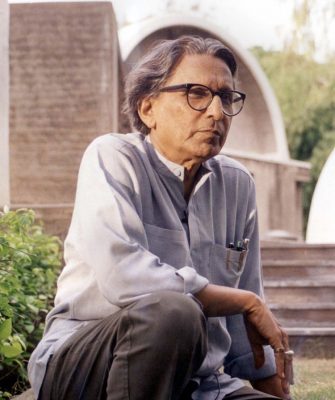
Balkrishna Doshi photo courtesy of VSF
Professor Balkrishna Doshi, India, selected as the Pritzker Architecture Prize 2018 Laureate
Mar 1, 2017
2017 Pritzker Architecture Prize
RCR Arquitectes – Rafael Aranda, Carme Pigem and Ramon Vilalta have been selected as the 2017 Pritzker Architecture Prize Laureates.
Pritzker Architecture Prize 2017 Laureates
Pritzker Prize Winner in 2016 – Alejandro Aravena, Chile
Pritzker Prize Architect winners
Chronological:
Balkrishna Doshi 2018 – see RIBA 2022 Gold Medal for Architecture
RCR Arquitectes 2017
Alejandro Aravena 2016
Frei Otto 2015
Shigeru Ban 2014
Toyo Ito 2013
Wang Shu 2012
Eduardo Elísio Machado Souto de Moura 2011
SANAA 2010
Peter Zumthor 2009
Jean Nouvel 2008
Richard Rogers 2007
Paulo Mendes da Rocha 2006
Thom Mayne founder of Morphosis Architects, Pritzker Prize Winner in 2005
Zaha Hadid 2004
Jørn Utzon 2003
Glen Murcutt 2002
Jacques Herzog & Pierre de Meuron Pritzker Prize Winners 2001
Rem Koolhaas 2000
Norman Foster 1999 of Foster + Partners
Renzo Piano 1998
Sverre Fehn 1997
Rafael Moneo 1996
Tadao Ando 1995
Christian de Portzamparc 1994
Fumihiko Maki 1993
Alvaro Siza 1992
Robert Venturi 1991
Aldo Rossi 1990
Frank Gehry 1989
Gordon Bunschaft + Oscar Niemeyer 1988
Kenzo Tange 1987
Gottfried Böhm 1986
Hans Hollein 1985
Richard Meier 1984
Ieoh Ming Pei 1983
Kevin Roche (Roche Dinkeloo Architects) 1982
James Stirling 1981
Luis Barragan 1980
Philip Johnson 1979
27 Feb + 31 May 2012
2012 Pritzker Architecture Prize Laureate
Wang Shu
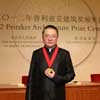
photo from ceremony
Thomas J. Pritzker, chairman of The Hyatt Foundation presented the 2012 Pritzker Architecture Prize to Wang Shu, the first architect from the People’s Republic of China to receive what is considered the most prestigious architecture award at the Great Hall of the People in Beijing. Renowned as the “the Nobel of architecture” the official ceremony was hosted for the first time in China since the prize was founded in 1979.
Wang Shu, a 48 year old architect whose architectural practice is based in Hangzhou, The People’s Republic of China, will be the recipient of the 2012 Pritzker Architecture Prize.
Jury Chair Lord Palumbo, stated, “Wang Shu’s oeuvre, seen in depth by the jurors during a visit to China, left no doubt that we were witnessing the work of a master; and a unanimous decision to award him the Pritzker Prize for 2012 is one that we feel places him at the same high level of distinction as the other Chinese architect to receive the award, I M Pei.”
Wang Shu – 2012 Pritzker Architecture Prize winner
In announcing the jury’s choice, Pritzker elaborated, “The fact that an architect from China has been selected by the jury, represents a significant step in acknowledging the role that China will play in the development of architectural ideals. In addition, over the coming decades China’s success at urbanization will be important to China and to the world. This urbanization, like urbanization around the world, needs to be in harmony with local needs and culture. China’s unprecedented opportunities for urban planning and design will want to be in harmony with both its long and unique traditions of the past and with its future needs for sustainable development.”
29 Mar 2011
2011 Pritzker Architecture Prize Laureate
Eduardo Souto de Moura is the 2011 recipient of the prestigious Pritzker Prize.
Pritzker Prize winner for 2011:
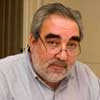
photograph : Augusto Brázio
Eduardo Souto de Moura is the second Portuguese architect to win the Pritzker – architect Álvaro Siza won the award in 1992.
Eduardo Souto de Moura – 2011 Pritzker Architecture Prize winner
Pritzker Prize 2010 : Information
Pritzker Prize 2010 Winner
SANAA, architects : Win 2010 Pritzker Prize
Winner – SANAA : Kazuyo Sejima (right) and Ryue Nishizawa (left)
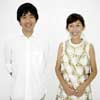
picture © 2008 Kazuyo Sejima + Ryue Nishizawa / SANAA ; photograph © Takashi Okamoto
The Pritzker Prize will be awarded to SANAA on 17 May 2010 by the Hyatt Foundation in Chicago. The winners will share the $100,000 prize, given annually since 1979 for “significant contributions to humanity and the built environment through the art of architecture.” Architects Sejima and Nishizawa will be presented with this prestigious architecture award in a ceremony on Ellis Island in New York Harbour, USA.
Sejima, born in 1956, and Nishizawa, born in 1966, are principals of the Tokyo-based architecture firm SANAA.
Naturally as soon as the Pritzker Prize Winner is announced for next year we will post it online here right away, thanks for your visit to e-architect.com
Pritzker Prize : further information re past winners
Location: Ellis Island, NY, USA
Pritzker Architecture Prize
Pritzker Architecture Prize Laureate 2011 : Citation from the Jury + The Jury + Eduardo Souto de Moura information
Pritzker Architecture Prize Laureate 2010 : Citation from the Jury + The Jury
Pritzker Prize Winner 2010 : SANAA architects
Architecture Awards
World Architecture Festival Awards
AR Awards for Emerging Architecture
Comments / photos for the 2024 Pritzker Architecture Prize winner, Riken Yamamoto page welcome

